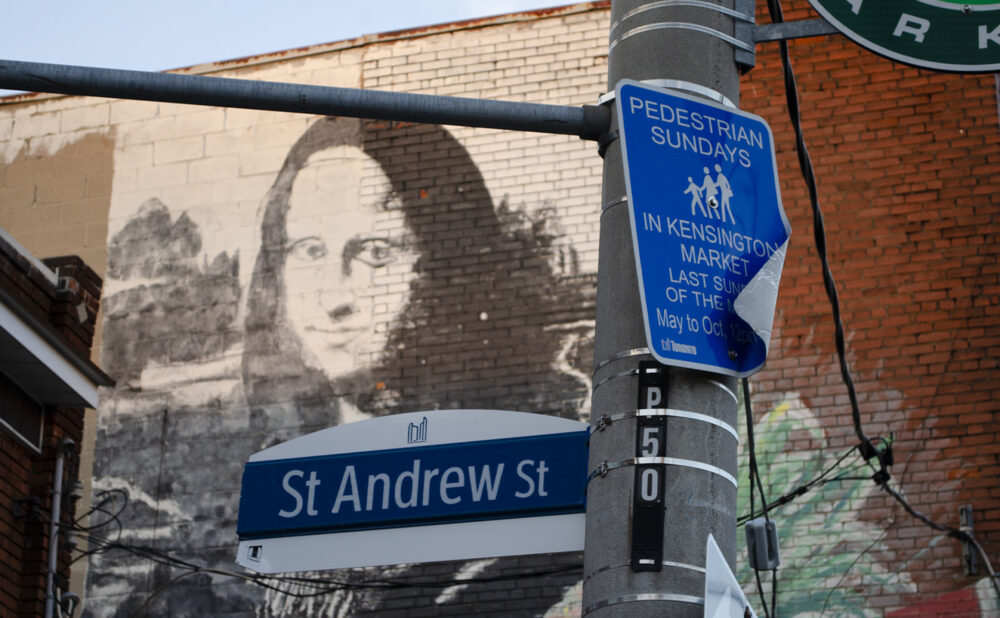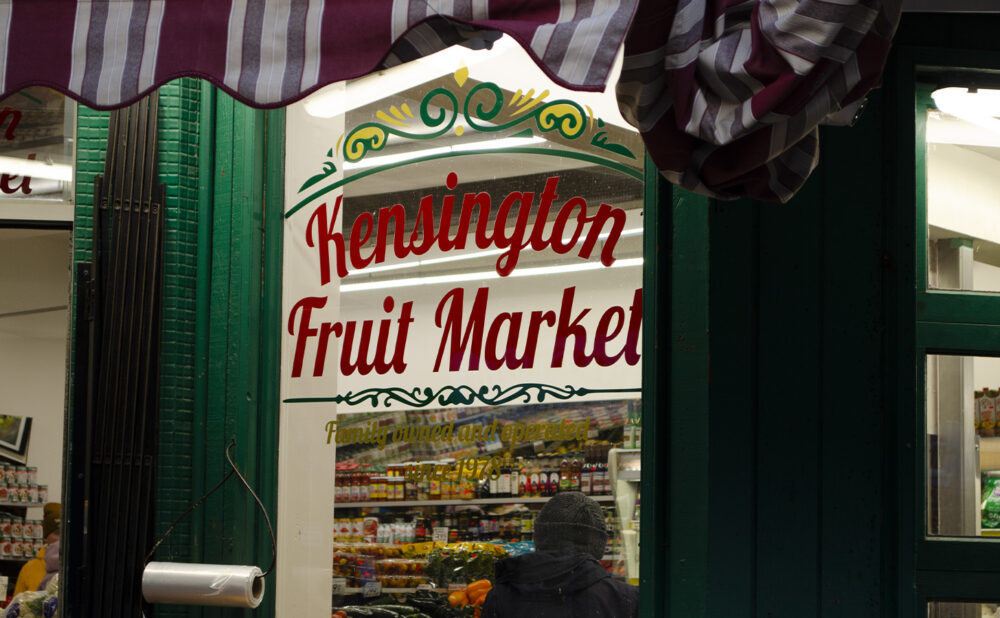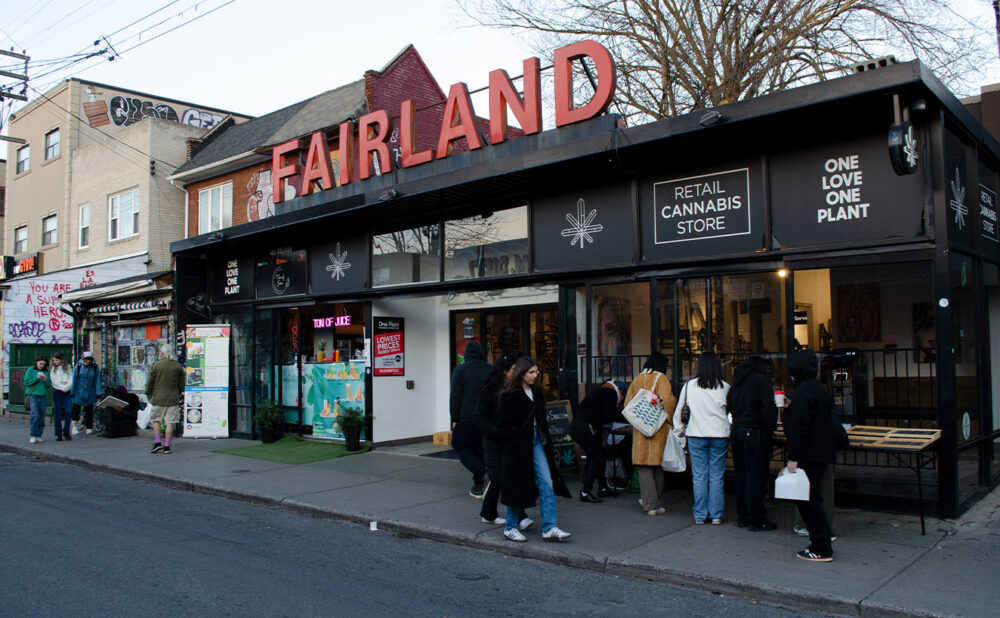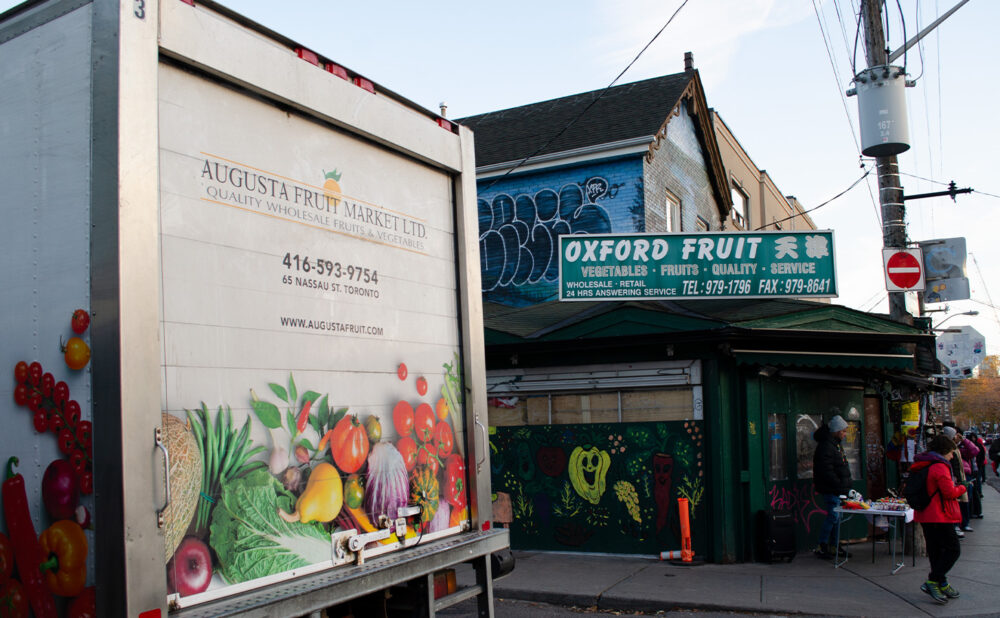Keep the market in Kensington
The fight over Kensington Market’s future
Kensington Market has what much of Toronto dreams of: walkable streets, locally owned small businesses and food retail, affordable housing and vibrant culture. It’s a blueprint for building liveable neighbourhoods everywhere.
Yet, over the last decade, Kensington Market has been losing what makes it so special. Many beloved local shops have been forced to close due to sky-rocketing rent, only to be replaced by upscale bars, restaurants and cannabis stores that can afford the rising costs. Big chains like Walmart and Starbucks have tried moving in, and Loblaws succeeded in 2016.
Once a home for marginalized outsiders, Kensington Market is becoming a trendy destination for the mainstream.
Dominique Russell, co-chair of the Kensington Market Community Land Trust, describes Kensington Market as having a “complex ecology,” one that’s currently under enormous pressure due to gentrification. “The opening of a Loblaws nearby meant the closure of food sellers, and in their place moved in more bars. That’s what we’re experiencing and now there’s an acceleration of that.”
KENSINGTON’S DISAPPEARING MARKET
- Oxford Fruit: Closed in 2020 after 40 years, reopened soon after with new owners only to close again last month.
- Sun Wah Fruit Market: Evicted in 2021 after 27 years in the market by new owners, who purchased the property for an estimated $4 million.
- Castle Fruit: Converted by its owners into a cannabis outlet, The Kensary, in 2021 despite a resident-led petition against it.
- Zimmerman’s Freshmart: Closed in 2016, replaced with cannabis mega-store One Plant in 2020.
- Emporium Latino: A beloved Latin-American grocer shuttered due to a fire in 2021.
It’s why she and other concerned residents created the Kensington Market Community Land Trust in 2017.
“Gentrification is a real estate problem, and it requires, at least to some extent, a real estate solution,” she says. “For the community to have a say in what’s happening in the neighbourhood, we need to own land — collectively.”
The land trust buys properties in the neighbourhood when they go on sale. It’s run democratically by its membership, which includes its tenants, neighbourhood residents and other supporters from across the city. “The idea is: you take land off the speculative market for community use,” says Russell.
Two years ago, the land trust was able to buy 54–56 Kensington Ave. — known as the “Mona Lisa building” for its recognizable mural. Prior to the sale, the landlord had served tenants with fake eviction notices, reportedly planning to set up an Airbnb “ghost hotel.” Thanks to the land trust, the tenants were able to keep their homes. It’s a purchase that was made possible thanks to funds made available by the city and the support of the local city councillor at the time, Mike Layton.
Still, the land trust depends on financial assistance to be able to move quickly to buy at-risk properties in the neighbourhood when they go up for sale. When the land trust wanted to buy 27 and 29 Kensington Ave. earlier this year, the current councillor, Dianne Saxe, was “unwilling to support” the purchase, Russell says.
In an email, Saxe says she, at the land trust’s request and as “a gesture of good faith and as a symbol of my commitment to the people of Kensington Market,” had already committed all of the roughly $2 million in Section 37 funds at her discretion to a project that will convert the parking lot at 25–35 Bellevue Ave. into new affordable housing. Her commitment then encouraged the city and the federal government to fully fund the project.
Russell, though glad to have the support of the councillor, disagrees with this assessment, saying work had been underway on this project by the Housing Secretariat since 2018.
Saxe says that after the funds were committed to that project, they could not be later redirected towards the purchase of 27 and 29 Kensington Ave. Russell believes that the use of this funding is ultimately at the councillor’s discretion — pointing to Layton’s ability to quickly unlock funding for the purchase of 54–56 Kensington Ave. that had similarly been earmarked for the Bellevue project.
KENSINGTON’S “SAFE STREETS”
It’s against this backdrop that City Hall has stepped into a fight over “safe streets.”
With necessary water main and road maintenance projects coming up in the area, city staff saw an opportunity for bigger and more ambitious changes to the neighbourhood.
As the Kensington Market Safe Streets project website puts it, this is a “once-in-a-lifetime opportunity to redesign the streets in a way that puts pedestrians first,” with measures such as pedestrian-only zones, raised intersections and sidewalk-widening.
Yet, there’s been vocal opposition to the project’s plans from neighbourhood residents.
Serena Purdy, the Chair of Friends of Kensington Market, has concerns about how the project may change the character of the neighbourhood and says there are questions over “how many stores can survive during the construction process, and how people will get around … It’s going to be the most major shift we’ve seen in the market for quite a long time.”
Russell agrees. “Big public works projects like this are gentrifying projects,” she says. “A lot of people are like, ‘Well, you know, the market is going to change anyway, so we might as well just accelerate it,’” says Russell. “And I hear from people who think, ‘No, we should pedestrianize it. We should do things like Europe. We should do things like Montreal.’ There’s no understanding of what’s actually there.”
Indeed, the city wants to further pedestrianize a neighbourhood already well known for being pedestrian-oriented, so why fix what isn’t broken?
Becky Katz, Manager of Pedestrian and Cycling Projects for the city, says plans for pedestrianizing Kensington Market came out of consultations with the community and stakeholders. “It was actually not part of the original scope” of the project, she says.
Saxe says there was “substantial public support” for pedestrianization from residents both “inside and outside the market” over the three rounds of public consultation.
On concerns about how much disruption the project will cause, Katz says that they have been working to “take proactive measures to reduce the timeline of construction.” Their goal is for the project to take a maximum of about two years to complete once underway, but they don’t yet have a firm schedule.
Russell, though, points to the work happening nearby on College Street to install separated bike lanes, saying, “This work was supposed to be finished in May, and it’s still ongoing. And all of that’s understandable, but that has an impact on businesses. And that will have a huge impact on the neighbourhood.”
Staff are reviewing the possibility of “financial mitigation” for businesses hurt by the disruption, Katz says.
“It’s just a mess,” says Russell. “But I still have optimism in just how strong the community remains, because these forces have been at work for a really long time.” Despite the enormous pressure the market has been under, “There’s one fruit stand, there’s one butcher, there’s two cheese places, there’s two fish markets — and, really, for 2023, that’s kind of still amazing for our neighbourhood.”
WHAT CAN I DO?
- Become a member of the Kensington Market Community Land Trust and donate to it.
- Tell your city councillor to help fund the Kensington Market Land Trust’s mission to protect the neighbourhood’s economic and social diversity.
- Write to your city councillor and tell them to support giving financial aid to local businesses impacted by the “Safe Streets” project.
- Go to Kensington Market and shop at independent local businesses.
- Buy your groceries from Kensington Market food sellers.









